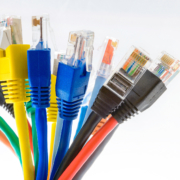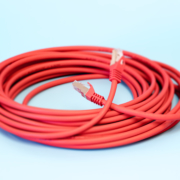CAT5e FTP vs UTP
Shielded or Unshielded Cat5e?
UTP stands for Unshielded Twisted Pair and FTP stands Foiled Twisted Pair. As the name suggests UTP cable do not have any shielding. The cables have a single plastic sleeve of insulation around the wires. In contrast, FTP cables have a metal shield around all pairs. Additionally, the cables also have an outer plastic sleeve insulation. The additional shielding provides extra security for the cable and then foil protects the wires from EMI and crosstalk. When choosing between the two options, the focus should be on outside interference that may be present. Generally, most installations for Cat5e and Cat6 are undertaken with UTP Data cabling. Thus a UTP cable is more than suitable for your installation. In certain situations, some manufacturers will specify that a shielded cable should be used. In this article we will explore Cat5e FTP vs UTP.
Cat5e cables (general outline)
Cat5e cables have the ability to transmit data speeds of 100MBps over 100metres. Furthermore, this allowance is commonly for a 90m permanent cable link, with an allowance for 5m patch leads at each end. Cat5e cables contain four twisted pairs, unlike newer categories such as Cat6, Cat7 and Cat8. Cat5e has no additional separation inside the cable between the pairs.
As the first major standard for data cabling installations, with the ability to handle 1 Gigabit traffic. Cat5e was a suitable choice for various hardware uses such as, computers, CCTV, telephones, Wi-Fi, access control and many others. However, with the advancement in technology, modern installations are better suited with Cat6, cat6a and even Cat7 cables. These newer cables offer better transmission speeds and better crosstalk protection.
Cat5e Cable Features
- They form part of a structured cabling design
- The cables are rated for 100MHZ, high speed data applications
- Capable of Gigabit Ethernet
- Consists of 4 pairs of coloured cores
- Cost effective
- Cable lengths of 90m or 100m
Where would Standard Cat5e cables be used?
Majority of installations can be undertaken with Cat5e cables. In addition, these would be specified in all new installations as CPR compliant cables.
Construction Products Regulation (CPR Regulations). All cables manufactured after 1st July 2017 are subject to these regulations. CPR was put in place to ensure all construction and building cables are manufactured to a certain standard. Furthermore, the regulations ensure that the cables are safe in case of a fire. CPR regulations apply to all categories.
Cat5e FTP vs UTP Cable- Advantages of a shielded cable
As previously stated, the main advantage of a shielded cable is that they protect the inner cores from electrical interference. The shielding protects the cable from all elements of EMI or Electromagnetic interference. EMI can be defined as electrical interference that is found naturally in the outside world or outside your cabling installation. For example:
- Nature – lighting, storms
- Electrical equipment
- Powerlines
- WI-Fi
- Mobile Phones
- Microwaves
- Generators
- Ligting
- Electrical Installations
Where should I use Shielded data cables?
Shielded cables should be used in areas where electrical interference can be a disruption. The following areas are examples of where you might find high levels of electrical interference:
- Warehouses
- Travel centres
- Industrial
- Distribution Centres
- Data Centres
- Medical Buildings
How do you know if a Cat5e cable is shielded?
The most obvious proof of any data cable being shielded will be the visible foil shielding around the cable. The shielding will either be around all four pairs or on each pair of cores. Another sign will be a drain wire. This is a metal wire which is separate from the four main pairs. Commonly, the drain wire is clearly visible in all data cables. In contrast, a UTP cable will have no shielding or drain wire present
Do shielding Ethernet cables need to be grounded?
Yes, shielded ethernet cables should be grounded. Each cable and connection medium such as a module, panel or jack will have different termination methods. Failure to correctly terminate the ground correctly will result in a losing the benefits of being shielded.




